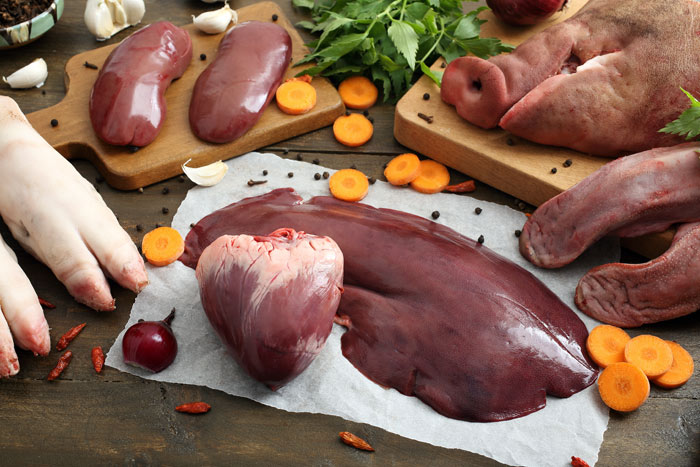Overcome Your Gut + Digestive Issues With Ancestral Nutrition
8 types of organ meats and their nutritional benefits

Organ meats are like nature’s vitamins. They are extremely rich in nutrients and can greatly benefit your health. Consuming organ meats can improve:
- nutrient consumption
- energy production
- immunity
- red blood cell function
- organ function
- eye health
- DNA synthesis
- and more
Long ago, people made use of the entire animal. They ate both muscles and organs, made broth from the bones, and made tools and clothes from the hide and bones. Although organ meats have lost their popularity in modern society; many people in the ancestral, paleo, primal, and nose to tail communities strongly advocate the benefits of organ meats.
Types of Organ Meats:
1) Liver

Liver, especially beef liver, is the king of organ meats. By this I mean it’s the richest in nutrients. It’s also great for boosting low iron levels since liver is rich in both iron and copper (cooper increases iron absorption). If you’re only going to consume one organ meat, I recommend you make it liver. However, be aware that liver tends to have a strong metallic flavor that can be off-putting.
To decrease the metallic flavor, soak the liver in milk or lemon juice for 30 minutes before cooking, do not overcook the liver (it should be pink on the inside when done), and add complementing flavors that offset the strong liver taste (like bacon, thyme, lemon juice, or oregano). If you want to try cooking liver, here are two of my go to recipes: Bacon Beef Liver Pâté Recipe and Sautéed Liver With Steamed Broccolini, Roasted Carrots and Onions, and Pesto.
However if you really can’t stand the taste of liver, there are products like beef liver capsules and beef liver crisps that pack the nutrient punch without the strong flavor.

2) Heart

Heart is a great organ to start with. It’s consistency and taste are more similar to that of muscle meat than other organs. This familiarity makes easing into organ meats easier.
You can get a heart from a chicken, cow, lamb, deer, elk, etc. Chicken hearts are very small compared to the larger hearts of cows, lambs, deer, and elk.
Heart is lean and can become tough and rubbery if overcooked. So don’t overcook it! You can cook heart like a steak or use it in other recipes. One of my favorite heart recipes is this heart bolognese sauce by Georgia from Stirring Change Nose-to-Tail Nutrition.

3) Kidney

Kidneys can be grilled, pan fried, or boiled. Some people choose to soak them in water, milk, or water with lemon juice for a few hours before cooking. This step is optional, but recommended for beef kidney due to its stronger flavor.
Kidneys have a soft texture and full flavor when cooked on the rarer side. If cooked well done, kidneys can become firm, dry, and slightly rubbery. For this reason I recommend cooking kidneys rare, medium-rare, or medium.

4) Sweetbreads (Thymus and Pancreas)

Despite their confusing name sweetbreads have nothing to do with bread or sweets. In fact sweetbreads are the thymus and pancreas organs.
Sweetbreads are higher in fat than most organs making for a less intense flavor and texture. Sweetbreads are soft and tender. They are typically soaked; then grilled, braised, or pan fried. Sweetbreads are also a rare case of an animal food with high levels of Vitamin C.

5) Brains

Brains have a soft texture similar to that of scrambled eggs. Brains can be pan-fried, boiled, or mixed in with another dish like scrambled eggs.
Clinically trained nutritionist, Georgia Lienemann says, “Traditional cultures trusted the principle of ‘like heals like’. That consuming the organs of healthy animals supports the functioning of our own” (10). Today, eating brain is still believed to benefit brain health due to the high levels of Vitamin B12, omega 3 fatty acids, and Vitamin C. All of which are key nutrients for brain health and cognitive function.
With that being said, be aware that beef brain (especially from cows older than 30 months) can carry mad cow disease. If an infected brain is eaten, it can cause Creutzfeldt-Jakob disease (a deadly neurodegenerative disorder) (11, 12). Although this is not very common, I still recommend getting brain from lamb, pork, or another non-beef source just to be safe.

6) Gizzards

The gizzards are part of the digestive track of some animals, including chickens, and are responsible for chewing. “When the chicken swallows grit and small stones, the gizzard contracts to serve as a grinder, since chickens have no teeth” (15).
Gizzards are a little crunchy and can become tough if cooked too quickly. Low and slow cooking with moisture will help reduce toughness. With that being said, gizzards can be fried, boiled, grilled, or mixed in with other foods like soup. I typically just sauté the one gizzard that comes with a whole chicken and eat it with my meal.

7) Tripe

Tripe is the edible muscle walls that line the stomach from ruminant animals such as cows, sheep, deer, antelope, giraffes, and more. It has a chewy texture and mild flavor, typically taking on the flavor of whatever it’s cooked with. It can be boiled, fried, grilled, sautéed, or used in other dishes like soup.
There are 4 main types of tripe:
- Blanket or flat tripe: Smoother in texture and comes from the first stomach chamber. This is considered the least desirable kind.
- Honeycomb tripe: More tender and palatable, looks like a honeycomb, and is from the second stomach chamber. This is considered the most desirable form of tripe.
- Omasum or book tripe: Is like a mix between blanket and honeycomb and comes from the third stomach chamber.
- Abomasum or reed tripe: Has two parts: a fattier smooth part with a strong taste and a rippled dark part that is more mild. It comes from the fourth stomach chamber (17).

8) Spleen

The spleen is an organ that hangs off the pancreas and is responsible for filtering blood and plays a role in immune response. It is another organ that is extremely high in Vitamin C, an uncommon thing for meat and animal products. Spleen is usually boiled and sometimes served in soup.

Functions of the Nutrients Found in Organ Meats:
| Nutrient | Function | Organs Nutrient Is High In |
| Vitamin A | DNA Synthesis Eye Health Skin Health Bone and Tooth Growth Immunity | Liver |
| Vitamin B1 (Thiamine) | Energy Production Immunity Nerve Function Heart Function Eye Health Kidney Function | Kidney |
| Vitamin B2 (Riboflavin) | Energy Production Eye Health Skin Health Red Blood Cell Formation | Liver Kidney Heart Gizzard Spleen |
| Vitamin B3 (Niacin) | Energy Production Nerve Health Skin Health Digestion | Kidney Heart Brain Gizzard Spleen |
| Vitamin B5 (Pantothenic Acid) | Energy Production Nerve Function Liver Function Digestive Health Red Blood Cell Formation Skin, Hair, and Eye Health Sex and Stress Hormone Production | Kidney Sweetbread Brain |
| Vitamin B6 (Pyridoxine) | Helps Detox Liver Metabolizes Protein, Carbs, and Fat Red Blood Cell Formation | Heart Kidney |
| Vitamin B9 (Folate) | Red Blood Cell Formation Protein Metabolism DNA Synthesis | Liver Kidney |
| Vitamin B12 (Cobalamin) | Red Blood Cell Formation Energy Production Nerve Function Brain Health | Liver Heart Kidney Sweetbread Brain Gizzard Tripe Spleen |
| Vitamin C | Antioxidant Increases Iron Absorption Immunity Protein Metabolism Brain Health | Sweetbread Brain Spleen |
| Choline | Cell Structure and Messaging Fat Metabolism DNA Synthesis Nerve Function Liver Function | Liver Heart |
| Copper | Supports Iron Absorption Antioxidant Red Blood Cell Formation | Liver Heart Brain |
| Phosphorus | Energy Production Protein Synthesis Regulates pH | Heart Kidney Sweetbread Brain Gizzard Tripe Spleen |
| Selenium | Reproduction Antioxidant Thyroid Function Immunity | Liver Heart Kidney Sweetbread Brain Gizzard Tripe Spleen |
| Zinc | Energy Production Immunity Protein and DNA Synthesis | Liver Heart Gizzard Tripe Spleen |
| Iron | Transports Oxygen Energy Production Immunity | Liver Heart Kidney Gizzard Spleen |
| Omega 3 | Eye Health Decrease Inflammation Brain Health Prevent Fat Build Up In Arteries | Brain |
Works Cited
1. Marcene, Brandi. “13 Foods That Are High In Vitamin B3.” Natural Food Series. 12 December 2018. https://www.naturalfoodseries.com/13-foods-high-vitamin-b3/
2. Rowles, Alexandra. “Why Liver Is a Nutrient-Dense Superfood.” Healthline. 7 June 2017. https://www.healthline.com/nutrition/why-liver-is-a-superfood
3. Schoenfeldrd, Laura, “Hate Liver? Eat it Anyway with These Tips.” lauraschoenfeldrd.com. 14 January 2015. https://lauraschoenfeldrd.com/hate-liver-eat-it-anyway-with-these-tips-paleo/
4.”Organ Meats: The Most Nutritious Parts of the Animal.” Spirtfoods. Accessed 27 September 2020. http://spiritfoods.net/health-benefits-of-organ-meats/
5. “Beef Heart.” Eat This Much. Accessed 3 September 2020. https://www.eatthismuch.com/food/nutrition/beef-heart,2763/
6.”Beef Kidneys.” Braeside Butchery. Accessed 27 September 2020. https://shop.braesidebutchery.co.za/product/beef-kidneys/
7. Joseph, Michael. “Organ Meats: 10 Healthy and Nutritious Options.” Nutrition Advance. 1 October 2018. https://www.nutritionadvance.com/organ-meats/
8. “What Are Sweetbreads?” Dartagnan. Accessed 27 September 2020. https://www.dartagnan.com/what-are-sweetbreads.html
9. “Beef Brain.” Meat One. Accessed 27 September 2020. https://www.meatone.net/product/beefBrain
10. Lienemann, Georgia. “Nose to Tail for Beginners: Brainy Frittata.” Stirring Change. 1 February 2017. https://stirringchange.com/2017/02/01/nose-to-tail-brains/
11. “Mad Cow Disease.” Health Link BC. 26 January 2020. https://www.thoughtco.com/mad-cow-disease-overview-602185
12. Helmenstine, Anne Marie. “Mad Cow Disease.” Thought.Co. 4 November 2019. https://www.healthlinkbc.ca/health-topics/tu6533
13. “Lamb, Variety Meats and By-products, Brain, Raw Nutrition Facts and Calories.” Self Nutrition Data. Accessed 26 September. https://nutritiondata.self.com/facts/lamb-veal-and-game-products/4654/2
14. “Frozen Chicken Gizzard Suppliers.” Euroasiaie. Accessed 27 September 2020. https://www.euroasiaie.com/products/frozen-chicken-gizzard-suppliers/
15. Kerr, Gord. “Are Chicken Gizzards Nutritious?” Live Strong. 22 January 2019. https://www.livestrong.com/article/325195-nutritional-values-of-chicken-gizzards/
16. Giardina, Courtney. “What is tripe and is it good for you?” Mashed. 2 October 2019. https://www.mashed.com/168391/what-is-tripe-and-is-it-good-for-you/
17. Kubala, Jillian. “What Is Tripe? A Nutritious Organ Meat Explained.” Healthline. 18 December 2018. https://www.healthline.com/nutrition/tripe#nutrition
18. Kerr, Gord. “4 Health Benefits of Tripe and Why It’s Better Than Steak.” Live Strong. 29 December 2018. https://www.livestrong.com/article/470909-is-tripe-good-for-you/
19. “Pig’s Spleen on Toast.” Culinary Pen. 12 April 2013. http://www.culinarypen.com/2013/04/pigs-spleen-on-toast.html
20. “Why You Should Eat Organ Meats.” Carnivore Aurelius. 22 March 2020. https://carnivoreaurelius.com/why-you-should-eat-organ-meats/
21. Raman, Ryan. “7 Impressive Ways Vitamin C Benefits Your Body.” Healthline. 19 February 2020. https://www.healthline.com/nutrition/vitamin-c-benefits
22. Narsaria, Rachita. “Vitamin B1 (Thiamine).” Med India. 13 January 2020. https://www.medindia.net/patientinfo/vitamin-b1.htm
23. “Vitamins: Their Functions and Sources.” University of Michigan. Accessed 4 September 2020. https://www.uofmhealth.org/health-library/ta3868
24. Roberts, Sue. “What Is the Main Function of Phosphorus in the Body?” SF Gate.12 December 2018. https://healthyeating.sfgate.com/main-function-phosphorus-body-5789.html
25. Brown, Mary Jane. “What Is Choline? An Essential Nutrient With Many Benefits.” Healthline. 7 December 2018. https://www.healthline.com/nutrition/what-is-choline#what-it-is
26. Morris, Rebecca. “What Does Vitamin B5 Do?” Healthline. 15 August 2018. https://www.healthline.com/health/vitamin-watch-what-does-b5-do
27. Kubala, Jillian. “7 Science-Based Health Benefits of Selenium.” Healthline. 20 August 2019. https://www.healthline.com/nutrition/selenium-benefits#1
28. Shaffer, Catherine. “Iron Functions in the Body.” News Medical. 26 February 2019. https://www.news-medical.net/health/Iron-Functions-in-the-Body.aspx

